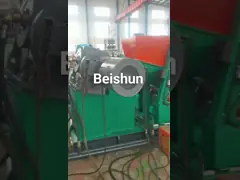Product Details
The 10-Inch Rubber Open Mill With Electric Pitch Adjustment Is
Suitable For Small-Scale Production
Product introduction:
A 10 - inch rubber mixing mill is a crucial piece of equipment in
the rubber - processing industry.
1. General Description
It typically consists of two rollers. The rollers are usually 10
inches in diameter, which is a significant feature that determines
the scale and capacity of the mixing process. These rollers are
made of high - quality materials such as alloy steel or chilled
cast iron. The surface of the rollers is designed to have high
hardness and excellent wear - resistance to ensure a long - service
life and maintain the precision of the mixing operation.
2. Working Mechanism
- Shearing Force: As the two rollers rotate in opposite directions, the rubber
material placed between them is subjected to a powerful shearing
force. This shearing action breaks the polymer chains of the
rubber, allowing for better dispersion of additives like fillers
and chemicals. For example, when carbon black is added to the
rubber, the shearing force helps to distribute it evenly throughout
the rubber matrix, which is essential for improving the physical
properties of the final rubber product such as tensile strength and
abrasion resistance.
- Compression and Kneading: The rollers also apply pressure on the rubber, squeezing out air
bubbles and any trapped moisture. The kneading effect is achieved
as the rubber is continuously drawn into the nip between the
rollers, folded, and turned over. This repeated process helps to
blend different rubber components and additives thoroughly. For
instance, in the production of rubber compounds for seals, the
kneading action ensures that the plasticizers and antioxidants are
well - incorporated into the rubber to enhance its flexibility and
durability.
3. Key Components and Their Functions
- Roller Adjustment System: The distance between the two rollers can be adjusted according to
the specific requirements of the rubber - mixing process. This
adjustment allows for different thicknesses of the rubber sheet to
be produced and also accommodates the varying viscosities of
different rubber formulations. For example, for a softer rubber
compound, a slightly wider roller gap might be used compared to a
harder compound.
- Drive System: Comprising an electric motor, a reducer, and couplings, the drive
system provides the necessary rotational power to the rollers. The
speed and torque of the rollers can be precisely controlled to
ensure the optimal mixing conditions. The rotational speed of the
rollers can range from a few revolutions per minute to higher
speeds depending on the type of rubber and the mixing intensity
required.
- Temperature - control System (if available): Some advanced 10 - inch rubber mixing mills are equipped with a
temperature - control mechanism. This system uses heating or
cooling media to maintain the rollers at a specific temperature.
The control of the roller temperature is vital because the
viscosity of the rubber is highly temperature - dependent. For
example, in the case of thermosensitive rubber materials,
maintaining a consistent temperature during mixing can prevent
premature cross - linking or hardening of the rubber.
4. Applications
- Automotive Industry: It is widely used in the production of various automotive rubber
parts such as tires, hoses, and seals. In tire manufacturing, the
mixing mill is used to blend natural rubber and synthetic rubber
with other components like vulcanizing agents and reinforcing
fillers to create the rubber compound that forms the tire tread and
sidewalls.
- Industrial Rubber Goods: For the production of industrial rubber products such as conveyor
belts, gaskets, and vibration - damping mounts. The mixing mill
ensures that the rubber compounds have the right consistency and
homogeneity to meet the specific performance requirements of these
products. For example, in the production of conveyor belts, the
rubber compound needs to have good tensile strength and wear -
resistance, which are achieved through the proper mixing of rubber
and additives in the mixing mill.
Company Profile
Qingdao Beishun Environmental Protection Technology Co., Ltd. is
engaged in Environmental protection machinery, rubber machinery R &
D and manufacturing enterprises, located in the west coast of
Qingdao ---- Jiaonan city, Qingdao Economic and Technological
Development Zone, adjacent to the former Bay near Qingdao Port and
International Airport Jiaodong airport, excellent geographical
location.
The company gathered a large number of the industry's outstanding
technical and management personnel, advanced machining, heat
treatment equipment and sophisticated detection equipment. With
high-quality service, advanced equipment and strong technical force
as the basis, through constant innovation and development, Beishun
Environmental Protection Technology machinery has many customers at
home and abroad to establish a stable business relationship, and
gradually establish a brand in the same enterprise.
Companies adhere to the "first-class quality to gain market
confidence, quality service to win customer satisfaction,
continuous improvement of enterprise development seek to establish
a corporate brand management excellence" business philosophy, in
terms of quality, brand and work hard to achieve the strategic
goals of common development.
Qingdao Beishun Environmental Protection Technology Co., Ltd. will
carry forward the "realistic, innovative, rigorous and efficient"
business style, good governance, integrity first, with a high sense
of responsibility "in customer service, service to the community",
with industry colleagues mutual benefit, for a better tomorrow.





